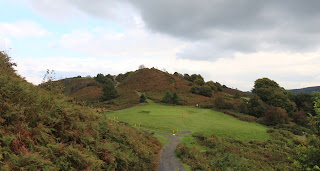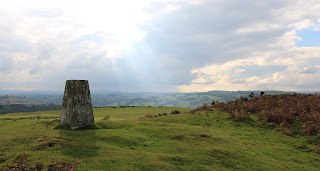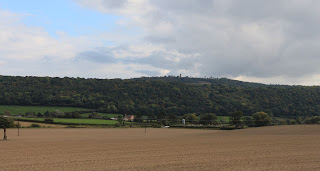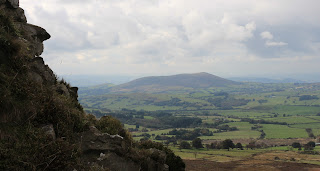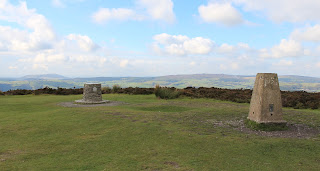10 October 2016
Participants: Only me
Where: Corndon Hill, 513m/1683', Sub-2k Marilyn, Map 137, SO 306969: Stiperstones, 536m/1760', Sub-2k Marilyn, Map 137, SO 368987: and Long Mynd - Pole Bank, 516m/1694', Sub-2k Marilyn, Map 137, SO 415944
There are a lot of sub-2k Marilyns within a short distance of Shrewsbury, where I was based, but I decided to concentrate on these that had a bit of additional interest, e.g., good views, geological features, hill forts and so on. Weather wise, it looked like being the best day of the week so I decided to visit three of the bigger and more well known hills, Corndon Hill, which is actually a couple of miles over the Welsh border, Stiperstones, and the Long Mynd. A feature of the day was the number of Red Kites that I spotted, they are certainly well re-established in this neck of the woods. Here is the first objective, Corndon Hill.....

There was a small car park to the north of the hill, provided for visitors to a stone circle. I didn't bother visiting the standing stones as there only appeared to be a few stones left and there are better examples in Scotland. A farm track led to a gate in the fence and a sign informing me that I was permitted to climb the hill from that point. Lots of folk appear to have taken up the offer as there was a well developed path that led all the way to the top, steeply in places. As forecast, the early morning mist was dispersing and it was turning into a beautiful day. Here are a couple of views looking further into Wales.....
I got a pleasant surprise when I reached the summit- there was a seat.....
How they got this up the hill I don't know because it was a really solid structure. Anyway, it was welcome and I sat on it for a while taking in the views including to Heath Mynd, another Marilyn which was not on my to do list this visit.....
and to Stiperstones, which was next on my list.....
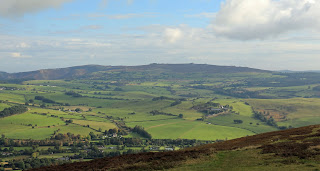
Stiperstones is a 10 kilometre quartzite ridge which includes a number of prominent jagged tors of which Manstone Rock is the highest point. Unsurprisingly, given the jagged, rocky nature of the landscape, Stiperstones is also rich in legend, particularly featuring the Devil.....
On the way to the hill, I stopped at the Bog visitor centre. The area around Stiperstones used to be a big mining area and at one time produced around 10% of Britain's lead ore. The Visitor Centre, formerly the village school, tells the story of mining in the area and is well worth a visit. Apparently, at one time the Bog was a bustling village but most of the houses are now long gone. There is a car park at the Bog and a path from there up the hill but I chose to carry on to a higher car park and shorten the walk a bit. My excuse was that I still had another hill to do after this one.
A walk taking in the whole ridge would be well worthwhile as it sits high above the surrounding countryside. There was a good view of Corndon Hill to the west.....
while to the east across another valley was my next objective, the Long Mynd.....
Here are some views along the ridge including some of the tors.....
There was no mistaking the highest point (the figure to the right gives it's scale).....
I reached the trig by way of a short easy scramble on the west side, it was a great perch.....
Then it was back to the car and a drive along narrow country lanes- and I mean narrow! They took me down into another valley and then up again to another ridge, the Long Mynd, whose highest point, Pole Bank, was another Marilyn.
Long Mynd was one of the easiest Marilyns that I have done; "climbed" would be to totally misrepresent the facts. There was another high car park and a smooth track along the ridge to the highest point involving no more than 30m of height ascent.....
There was both a trig and a topograph; both pictures have Corndon Hill and Stiperstones in the background.....
Stiperstones again.....
On the east side of the ridge was another valley, the one that contains a number of villages including Church Stretton. However, none of the valley can be seen from the ridge; what can be seen (just) is another Marilyn to the east, Caer Caradoc, on my list for later in the week......
The Long Mynd has lots of good walking but on its flanks rather than on the ridge itself. Nevertheless, I found this a fascinating days hillwalking with three different and distinctive types of hill. And I only had to drive about 50 miles in total from base and back to bag them!











